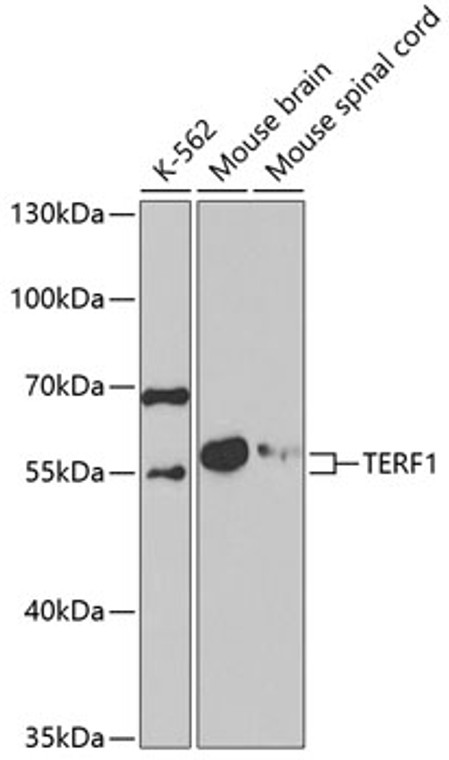| Host: |
Rabbit |
| Applications: |
WB/IF |
| Reactivity: |
Human/Mouse |
| Note: |
STRICTLY FOR FURTHER SCIENTIFIC RESEARCH USE ONLY (RUO). MUST NOT TO BE USED IN DIAGNOSTIC OR THERAPEUTIC APPLICATIONS. |
| Short Description: |
Rabbit polyclonal antibody anti-TERF1 (240-419) is suitable for use in Western Blot and Immunofluorescence research applications. |
| Clonality: |
Polyclonal |
| Conjugation: |
Unconjugated |
| Isotype: |
IgG |
| Formulation: |
PBS with 0.02% Sodium Azide, 50% Glycerol, pH7.3. |
| Purification: |
Affinity purification |
| Dilution Range: |
WB 1:500-1:2000IF/ICC 1:50-1:200 |
| Storage Instruction: |
Store at-20°C for up to 1 year from the date of receipt, and avoid repeat freeze-thaw cycles. |
| Gene Symbol: |
TERF1 |
| Gene ID: |
7013 |
| Uniprot ID: |
TERF1_HUMAN |
| Immunogen Region: |
240-419 |
| Immunogen: |
Recombinant fusion protein containing a sequence corresponding to amino acids 240-419 of human TERF1 (NP_003209.2). |
| Immunogen Sequence: |
IKSYVNYVLSEKSSTFLMKA AAKVVESKRTRTITSQDKPS GNDVEMETEANLDTRKRSHK NLFLSKLQHGTQQQDLNKKE RRVGTPQSTKKKKESRRATE SRIPVSKSQPVTPEKHRARK RQAWLWEEDKNLRSGVRKYG EGNWSKILLHYKFNNRTSVM LKDRWRTMKKLKLISSDSED |
| Tissue Specificity | Highly expressed and ubiquitous. Isoform Pin2 predominates. |
| Post Translational Modifications | Phosphorylated preferentially on Ser-219 in an ATM-dependent manner in response to ionizing DNA damage. ADP-ribosylation by TNKS1 or TNKS2 diminishes its ability to bind to telomeric DNA. Ubiquitinated by RLIM/RNF12, leading to its degradation by the proteasome. Ubiquitinated by a SCF (SKP1-CUL1-F-box protein) ubiquitin-protein ligase complex, leading to its degradation by the proteasome. |
| Function | Binds the telomeric double-stranded 5'-TTAGGG-3' repeat and negatively regulates telomere length. Involved in the regulation of the mitotic spindle. Component of the shelterin complex (telosome) that is involved in the regulation of telomere length and protection. Shelterin associates with arrays of double-stranded 5'-TTAGGG-3' repeats added by telomerase and protects chromosome ends.without its protective activity, telomeres are no longer hidden from the DNA damage surveillance and chromosome ends are inappropriately processed by DNA repair pathways. |
| Protein Name | Telomeric Repeat-Binding Factor 1Nima-Interacting Protein 2Ttaggg Repeat-Binding Factor 1Telomeric Protein Pin2/Trf1 |
| Database Links | Reactome: R-HSA-110328Reactome: R-HSA-110329Reactome: R-HSA-110330Reactome: R-HSA-110331Reactome: R-HSA-1221632Reactome: R-HSA-171306Reactome: R-HSA-171319Reactome: R-HSA-174411Reactome: R-HSA-174414Reactome: R-HSA-174417Reactome: R-HSA-174430Reactome: R-HSA-174437Reactome: R-HSA-2559586Reactome: R-HSA-9670095 |
| Cellular Localisation | NucleusCytoplasmCytoskeletonSpindleChromosomeTelomereColocalizes With Telomeric Dna In Interphase And Prophase CellsTelomeric Localization Decreases In MetaphaseAnaphase And TelophaseAssociates With The Mitotic SpindleColocalizes With Triobp Isoform 1 At The Telomeres In Interphase |
| Alternative Antibody Names | Anti-Telomeric Repeat-Binding Factor 1 antibodyAnti-Nima-Interacting Protein 2 antibodyAnti-Ttaggg Repeat-Binding Factor 1 antibodyAnti-Telomeric Protein Pin2/Trf1 antibodyAnti-TERF1 antibodyAnti-PIN2 antibodyAnti-TRBF1 antibodyAnti-TRF antibodyAnti-TRF1 antibody |
Information sourced from Uniprot.org
12 months for antibodies. 6 months for ELISA Kits. Please see website T&Cs for further guidance







